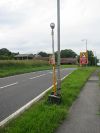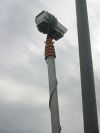Safety Cameras
| Safety Cameras | |
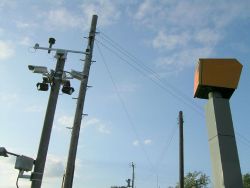 | |
| A variety of cameras on the A303 | |
| Pictures related to Safety Cameras View gallery (14) | |
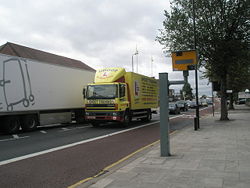 | |
| Pictures related to Gatso View gallery (26) | |
 | |
| Pictures related to Truvelo View gallery (8) | |
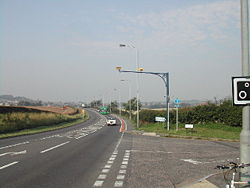 | |
| Pictures related to SPECS View gallery (28) | |
 | |
| Pictures related to Monitron View gallery (6) | |
Safety cameras, otherwise known to most people as speed cameras are devices for enforcing the speed limit on roads.
Introduction
Although deployment is contentious, use of safety cameras is widespread across the whole of the UK, government figures suggest they significantly improve road safety, local government statistics show a general reduction in casualties where the cameras are deployed, however campaign groups demonstrate using numerous methods that cameras do not improve road safety overall.
Roadside cameras have been with us since 1988 after Nottingham City Council sought a solution for red light violations after a triple fatality at a signal controlled junction. Soon afterwards, red light enforcement cameras spread across the country, the speed enforcement camera followed soon afterwards after receiving Home Office approval in 1992 for use as speed enforcement. The automatic enforcement cameras has had an affect on the deployment of Police Officers working on traffic related duties, speed enforcement at isolated sites now receive 24/7 enforcement, leaving officers to do other more productive work, which led to the early seeds of the mobile speed enforcement teams.
Camera types
Static Cameras
Gatsometer Generally known by the shortened name Gatso these were the first devices to achieve Home Office approval, cameras first started to appear in the UK as red light cameras in 1988 as a trial, later receiving approval for use as speed enforcement devices in 1992. Historically uses on wet film technology, with digital technology currently available for new sites. Gatso type cameras use radar to measure vehicle speed, then as appropriate captures two static images for use later evidential use in issuing tickets.
Truvelo The first forward facing speed enforcement camera, to allow identification of the driver. The system uses piezo sensors to measure the speed of a passing vehicle, then as appropriate
SPECS Time and distance cameras, designed to enforce over a long length of road. This kind of solution is very effective through motorway roadworks with typically reduced speed limits due to barrier works and the close proximity of road workers.
RedSpeed (Previously known as Monitron) This digital speed enforcement camera was approved for use from 2004. The system uses piezo detectors buried in the road surface to measure the speed of a passing vehicle, then as appropriate captures three digital images, a zoom shot of the vehicle's number plate, a wide angle shot showing make, model and colour, then after a short delay dependant on vehicle speed, a third image showing the vehicle is in motion.
SpeedCurb Digital time and distance enforcement camera, version of the RedSpeed camera, approved for use from 2004.
RedFusion Digital time and distance enforcement camera system that has yet to achieve Home Office type approval. Type Approval granted Jan 2010.
HADECS3 The Redflex Highways Agency Digital Enforcement Camera System 3 is a fixed point system that was introduced on the M25 in Kent in April 2014, becoming active on 22 October 2014.
Mobile Cameras
Gatsometer Vehicle or tripod mounted version of the standard roadside Gatso
Truvelo ProLaser III Covering a speed range of 5-200mph and a distance of 10-4500ft (3-1370m) the ProLaser II can be either hand held or mounted in combination with a data capture and digital video accessory for tripod or vehicle mounted operations. The device is aimed by the operator and the speed is calculated inside the unit, a digital video capture is required for post offense ticketing.
Red Light Violation Cameras
Gatsometer Red light violation enforcement camera, original version of the Gatso speed enforcement camera, approve for use by the Home Office in 1988
RedGuard Digital red light violation enforcement camera, a version of the RedSpeed camera, approved for use from 2004.
Combination Cameras
Truvelo D-Cam Multiple use camera for static, mobile, red light monitoring, lane monitoring and combined applications. The system uses a digital camera along with a both piezo and/or laser sensors.
Non Ticketing Cameras
Watchman Non ticketing device deployed notably in Tameside where offenders were issued with a letter from the local authority.
Other Deployments
Whilst the use of safety cameras is generally associated with speed and red light enforcement, other applications exist for enforcement of bus lanes, level crossings, high occupancy vehicle lanes and double white line systems, the identification of vehicles not paying tolls or congestion charges. Automatic Number Plate Recognition (ANPR) is also widely deployed by government agencies for road fund licence and emissions checks and by highways authorities for monitoring of travel times.
Back Office
GatsoView-CCD and Camera Interface Tool Systems for capturing digital and wet film images, digital images are encrypted to ensure they are tamperproof.
RedCheck Ticketing system for use with the RedSpeed range of cameras, with case history management, a document management system, automatic data and image capture from wet film and video, ANPR import of data, internet access for offence viewing, reporting on previous offence history for offenders and nominated drivers.
Enforcement
Enforcement thresholds are recommended by the Association of Chief Police Officers (ACPO) at the speed limit plus 10% plus 2mph i.e.
- 30mph + 10% + 2mph = Enforcement from 36mph
- 40mph + 10% + 2mph = Enforcement from 47mph
- 50mph + 10% + 2mph = Enforcement from 58mph
- 60mph + 10% + 2mph = Enforcement from 69mph
- 70mph + 10% + 2mph = Enforcement from 80mph
Enforcement in rural areas with a speed limit of 50mph or more has been acknowledged by some organisations to be at 5mph over the speed limit i.e.
- 50mph + 5mph = Enforcement from 55mph
- 60mph + 5mph = Enforcement from 65mph
- 70mph + 5mph = Enforcement from 75mph
Site Selection
Camera sites are selected on the basis of recorded speed related accidents, level of KSI's (Killed or Seriously Injured), the actual measured speed of traffic and the suitability of deployment sites.
- Recorded speed related accidents are looked at over a 3 or 5 year basis, accidents included should be the ones with causation factors such as speeding, loss of control, overtaking etc, where speed is a very likely cause of the accident. Some assessments have been made in the past and currently including all accidents, this is considered by many in road safety circles to be bad practice and is the cause of many issues relating to the inappropriate deployment
- Level of KSI's is another factor, where a site has several recorded slight injury accidents, deployment may not be as justifies, recorded serious or fatal accidents will raise the likelihood of deployment. Some authorities require a speed related KSI over 3 years for mobile sites or 4 KSI's over 5 years for static sites. Scoring systems for all accidents vary but in general, a score of 9-11 is required for a mobile site over 3 years and 30-36 for a static site over 5 years. With KSI's scoring 5 and slights scoring 1.
- Actual speeds are important, ACPO suggests that enforcement should be at certain thresholds above the posted speed limit. Deployment must be at sites where the 85th percentile speed is above the ACPO threshold, although some authorities are using the 90th percentile now. Sites with a specific speed problem over a period during the morning, day or evening can be considered, however care should be taken not to select sites on the basis of speeds during the night (12 midnight - 6am) as traffic volumes are very low and speeds can rise significantly above the thresholds, thus giving an inappropriate view of the real speed problem and making the camera deployment ineffective.
- Site suitability is something that can only be considered towards the end of the assessment process, deployment of cameras is influenced by the availability of space for a vehicle to do mobile enforcement, safe access for equipment, coverage of the specific speed related problem etc.
Links

